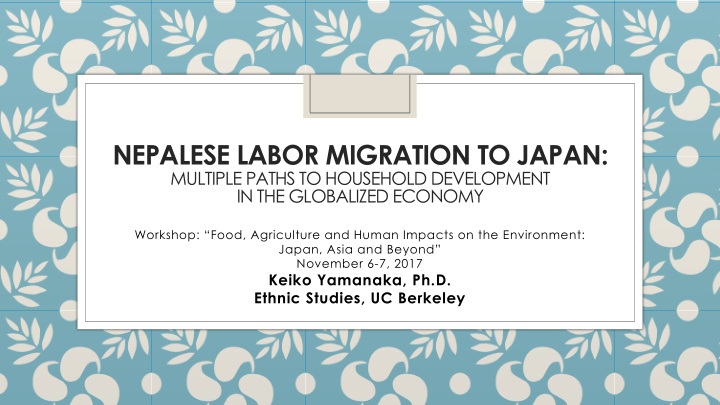



NEPALESE LABOR MIGRATION TO JAPAN: MULTIPLE PATHS TO HOUSEHOLD DEVELOPMENT IN THE GLOBALIZED ECONOMY Workshop: “Food, Agriculture and Human Impacts on the Environment: Japan, Asia and Beyond” November 6-7, 2017 Keiko Yamanaka, Ph.D. Ethnic Studies, UC Berkeley
Introduction: Migration in Asia ◦ Sociologist, teaching in Asian Studies & Asian American Studies ◦ Research: Immigration, Citizenship and Multiculturalism in Asia ◦ Labor exchange between : ◦ East Asia : Japan, Hong Kong, S Korea, Singapore and Taiwan ◦ Southeast Asia : Philippines, Indonesia, Vietnam, Myanmar, Nepal , . . . ◦ Dopulation, labor demand & supply, historical context ◦ Immigration policy: circular migration for unskilled labor ◦ Singapore, Hong Kong and Taiwan: Strict policy ◦ Japan and S Korea: ambiguous
Nepal : Environment & Development ◦ One of the most ecologically wealthy but economically distressed and Politically unstable countries in South Asia ◦ Rich in ecological diversities ◦ with 80% of the land covered by rugged hills and mountains ◦ Developmental activities created many environmental problems due to inadequate consideration and poor management ◦ Political changes, 1950s to 2010s, from absolute monarchy to democracy, especially impact of the 10-year civil war on the economy ◦ International migration as a viable strategy for family survival, increasing remittances but negative impact on agriculture and natural resource/ ecological management
Backgrounds ◦ I conducted research on “Nepalese labor migration to Japan” in the 1990s, 2000s ◦ Interviews and surveys ◦ Nepal: Kathmandu & Pokhara ◦ Japan: Shizuoka and Aichi Prefectures ◦ “Nepalese labor migration to Japan: from global warriors to global workers,” Ethnic and Racial Studies , 2000 ◦ Social ties and social capital (highly diverse groups, British Army Gurkha soldiers, ethnic & regional network) ◦ Visa-overstayers in the manufacturing industry ◦ Lively community activities during the weekends
A Quarter Century Later, 2010s ◦ Nepalese labor migration to Japan ◦ An increase of 10 times in number ◦ From 2,686 in 1995 to 55,236 in 2015 (registered residents) ◦ 2005 5,314 – ◦ 2006 6,596 24.1%+ Civil war ended in Nepal ◦ 2007 8,417 27.6%+ ◦ 2008 11,556 37.3%+ ◦ 2009 14,745 27.6%+ Global Economic Crisis ◦ 2010 17,149 16.3%+ ◦ 2011 20,103 17.2%+ ◦ 2012 24,071 19.7%+ ◦ 2013 31,537 31.2%+ ◦ 2014 42,346 34.3%+ New Constitution in Nepal ◦ 2015 55,236 30.4%+
Nepal’s Political History ◦ 1951 Absolute monarchy ◦ 1991 First Democracy Movement, Constitutional Monarchy ◦ 1996 Maoist People’s War began ◦ 2001 Massacre of the Royal Family ◦ 2006 Second Democracy Movement ◦ 2006 United Communist Party (Maoist), a coalition party ◦ 2008 The Federal Democratic Republic of Nepal ◦ Forming the Constitutional Assembly ◦ 2014 The Constitution of Nepal ◦ 2015 Great earthquakes (Mag 7.8, 9,000 died, 12,000 injured)
Nepal as a Labor-Sending Country ◦ Nepalis outside Nepal ◦ 1961 328,470 9,741,466 3.4% ◦ 1981 402,977 15,425,816 2.6% ◦ 2001 762,171 23,499,115 3.2% ◦ 2011 1,921,494 26,494,504 7.3% ◦ 2011 25% of the total households have a migrant ◦ Destinations (A total from 2006/07 to 2011/12) ◦ India 880,000 (free border) ◦ Middle East 1,070,000 (Qatar, Saudi Arabia, UAE) ◦ Malaysia 380,000 ◦ East Asia 100,000< ( Japan and South Korea)
Nepalese Labor Migration to Japan, 2010s~ ◦ 2008 Global Economic Crisis, Fewer manufacturing jobs, repatriation ◦ Diversification of visas to enter and reside in Japan ◦ 2014 Nepalese Residents ◦ International students 15,697 37.1% ◦ Family Stay 10,308 24.3% ◦ Skilled migrants 7,412 17.5% ◦ Other 1,692 3.9% ◦ Total 42,346 100.0% ◦ Japanese language & vocational school students, work 4 hours/day ◦ Cooks of Indian/Nepali restaurants and their families ◦ Working age, 20-29, 48% ◦ Children 12< 12%
Nepal: Migration & Remittance Economy ◦ Not only economic, demographic & environmental push of the sending society, but also historical and political contexts ◦ Increasing remittances from abroad (e.g., Philippines, Indonesia) ◦ Household Strategy ◦ Remittances in the globalized economy ◦ Diversify income sources, defuse risks ◦ National Economic Development ◦ Remittances > ODA ◦ National revenues but also social development ◦ During 10 years of Maoist conflict, poverty rate decreased from 42% in 1995 to 31% in 2004 ◦ Infant mortality rate improved significantly ◦ Labor migration alone does not develop a country ◦ Many social issues: fewer working age men in villages; unattended fields, natural resources, ecological degradation
Works Used ◦ Jha, Shree Gopal, 2007, “A brief appraisal of existing main environmental issue in Nepal and potential intervention to solve the Perceived problems,” Banko Janakri , Vol. 17, No. 1. ◦ Kharel, Dipesh 2016, “From Lahures to Global Cooks: Network Migration from the Western Hills of Nepal to Japan,” Social Science Japan Journal, Vol. 19, No. 2: 173- 192 ◦ Minami, Makito, 2017 ◦ 「移住労働が内包する社会的包摂」、名和克郎(編)「体制転換期ネパールにおける『包摂』の 諸相』三元社 ◦ Minami, Makito and Hiroshi Ishii, 2015 ◦ 「ネパール近現代政治史略年表」、南真木人 ・ 石井溥(編著)「現代ネパールの政治と社会」、 明石書店 ◦ Tanaka, Masako, 2016, “Not only job but also study: Rapid increase in migrant youth and children from Nepal in Japan.”
Recommend
More recommend